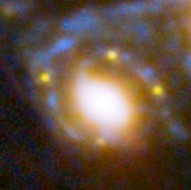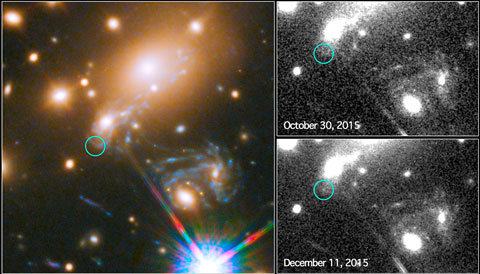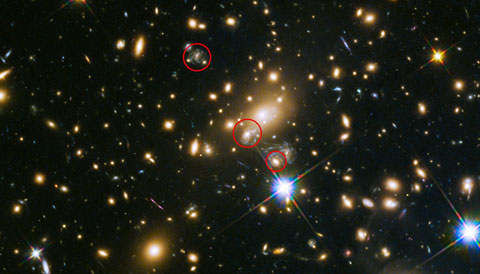Astronomers Predict a Supernova:
For the first time, astronomers have predicted the appearance of a supernova.

In November 2014, astronomers spotted the light from supernova Refsdal (yellow), which split into four images as it passed near an elliptical galaxy on its way to Earth.
NASA / ESA / S. Rodney & FrontierSN /T. Treu / P. Kelly & GLASS / J. Lotz & Frontier Fields / M. Postman & CLASH / Z. Levay
NASA / ESA / S. Rodney & FrontierSN /T. Treu / P. Kelly & GLASS / J. Lotz & Frontier Fields / M. Postman & CLASH / Z. Levay
Several months ago, we wrote about the discovery of Supernova Refsdal, an exploding star in a faraway galaxy, whose light had split into four images on its way to Earth.
Now astronomers have used the Hubble Space Telescope to spot the supernova — again! On December 11th, Patrick Kelly (University of California, Berkeley) and colleagues spotted a fifth image of the exact same explosion, more than a year after Hubble caught the previous four images.
The time travel trick occurs by way of gravitational lensing. The gravity of a massive object magnifies light sources in just the right place behind it and may distort or split their images.
In the case of Supernova Refsdal, the light traveled toward Earth for more than 9 billion years. On its way here, it passed near a massive elliptical galaxy.
Though a perfectly spherical galaxy would have created a ring, the oval-shaped galaxy instead created an Einstein’s Cross, splitting the supernova’s light into four images around the lensing galaxy.

Left: Hubble observed the galaxy cluster MACS J1149.5+2223 as part of the Frontier Fields program. The circle indicates the predicted position of the newest appearance of the supernova. The four Einstein Cross images of the supernova are visible to the lower right. Right: The image on the top right shows observations by Hubble from October 2015. The image on the lower right shows the discovery of the Refsdal Supernova on December 11th.
NASA / ESA / P. Kelly
NASA / ESA / P. Kelly
The cross images were the first four that Hubble captured in November 2014. But the galaxy is part of a larger cluster called MACS J1149.5+2223, one of the six lucky clusters getting lots of Hubble attention thanks to the Frontier Fields project. The cluster’s gravity — that is, not just its stars in galaxies but also its hot intergalactic gas, as well as its dark matter — created additional images.
A flurry of computer simulations published immediately after the supernova’s discovery showed that there was probably one supernova image we missed in 1998. And they all predicted that another image would be found within one to several years of the 2014 discovery. Though the models weren’t spot on in predicting the exact time and location of the fifth image, they all came close.
The new image’s brightness is still increasing, and Kelly’s team plans to wait until it begins to fade before analyzing the data further.

This illustration shows how the huge galaxy cluster MACS J1149.5+2223 magnified and distorted the light of Supernova Refsdal as its light passed through it, creating five different images of the same stellar explosion.
NASA / ESA
NASA / ESA
The supernova was named in honor of Sjur Refsdal (Hamburg Observatory, Germany), who, half a century before, had predicted that astronomers would one day spot such a supernova caught in a gravitational lens. The supernova will help shed light on the foreground galaxy cluster’s mass distribution. The cluster’s effect on the supernova’s light is too complex to use its five images to test theories about the universe’s expansion, as Refsdal had optimistically predicted could be done.
Read more about this fascinating object and all its various apparitions in the ESA/Hubble science releases of the appearance of the first four images and the discovery of a fifth image.

This wide-field view Supernova Refsdal's appearances. The uppermost circle shows the position of the supernova as it could have been seen in 1998. The lowermost circle shows the galaxy that lensed the supernova four times, as spotted in late 2014. The middle circle shows the fifth image, discovered on December 11th.
No comments:
Post a Comment